

|


Fruit Wallah
Prabhupada: "....take morning snana and capati. During very hot season they don't take even capati. They take some fruits, guava and this... What is called that? (Hindi)
Devotee (2): That? Melon.
Prabhupada: Melon, yes. During hot season you get watermelon, this other melon.
Hari-sauri: Honeydew melon.
Prabhupada: Honeydew melon, oh very nice. In the upcountries still in the village during daytime they don't eat. During daytime they take some fruits and at night when it is cool, the cool ah, refreshing air, they make some capati. One time, is it not?
Devotee (2): (Hindi)
Prabhupada: Eh, (Hindi) In that night because in daytime it is so hot, it is embarrassing to cook and to digest also. Better take food, ah, fruit, this melon, and at night they take 3 or 4 capatis according to the... And good sleep. Very happy life it was, all over India. There was no question of poverty. People did not know what is poverty and now it is poverty. They do not get even sufficient food.
Hari-sauri: Industrialization.
Prabhupada: Ugra-karma. I don't like industrialism."
Srila Prabhupada Room Conversation, 11-03-76, Vrindaban
|
Amla
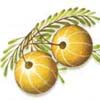
|
Amla fruit, also called Indian Gooseberry, is sour, sweet and astringent in taste. Amla has a cooling action and is good for the heart and upper respiratory system.
|
Atta
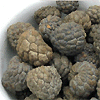
|
Atta fruits have a green and black knobby surface and creamy white flesh inside with large black seeds. It is available only during the autumn season. Atar payesh is the flesh of this fruit cooked in milk as a dessert.
|
Bael Fruit
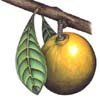
|
All parts of the Bael tree, including stem, bark, root, leaves & fruit at all stages of maturity, have medicinal value. Bael fruit is aromatic, cooling & laxative. The ripe or half-ripe fruit is good for digestion. Bael leaves are offered to Lord Siva.
|
Bilimbi
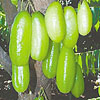
|
Bilimbi is also known as cucumber fruit or kamias. A cousin to starfruit, the Bilimbi resembles an overlarge cucumber with thin, shiny skin. The flesh lends pleasing sour balance to relishes, stews and curries.
|
Bread Fruit
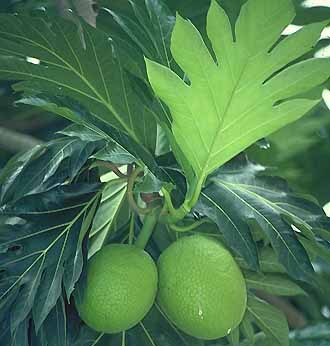
|
Breadfruit is a nutrition-packed, starchy fruit that grows on tall trees. The lime-green globes may weigh up to 10 pounds each. Also called Ulu, the Breadfruit in its green, immature state is similar to artichoke heart. While green and mature, it is often used like potato or rice. When fully ripe, its taste resembles sweet potato, squash or pumpkin.
|
Guava
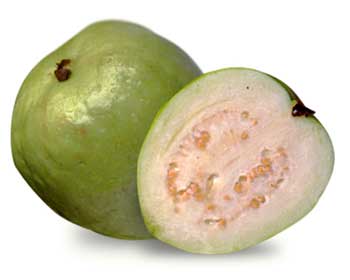
|
The guava is a small evergreen grown throughout the tropics, and comes from the same family as pimento, cinnamon, clove and nutmeg. There are many varieties of Guava, ranging from white-fleshed sweet types to pink-fleshed sour types.
|
Jack Fruit
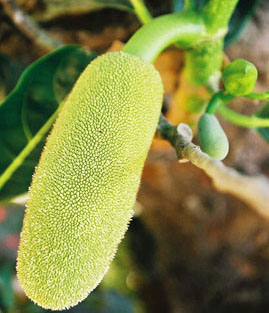
|
Jackfruit is the largest tree-borne fruit in the world, reaching 80 pounds in weight and up to 36 inches long and 20 inches in diameter. The exterior of the compound fruit is green or yellow when ripe. The interior consists of large edible bulbs of yellow, banana-flavored flesh that encloses a smooth, oval, light-brown seed. When fully ripe, the unopened jackfruit emits a strong disagreeable odor, resembling that of decayed onions, while the pulp of the opened fruit smells of pineapple and banana. There are two main varieties of Jackfruit, one having fruits that are small, fibrous, soft, and very sweet, while the other is crisp and not quite as sweet.
|
Jambu Fruit
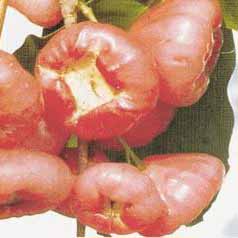
|
Jambu, known as Water Apple in India, grows on a tree. The fruits have an uneven shape, with a wide apex and narrow base. They may be white to bright pink in color. The pulp is crisp and watery, with a scented flavor, hence the name watery rose-apple. The skin contains a high content of vitamin A.
|
Litchies
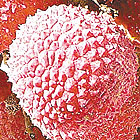
|
Litchis are a very sugary, succulent fruit with scaly red skin and a small brown seed. They have a fine-textured, white perfumed flesh that’s moist and sweet. Litchis originated in China and became very popular in India, beginning in Bengal in the 18th Century. They’re wonderful in salads, over ice cream, in syrups or as beverages, and are excellent frozen or dried.
|
|
Mango
Mangos grow in tropical and sub-tropical climates around the world. Mango trees are evergreens that grow up to 60 feet tall and produce a wide variety of fruits - more than 1,000 different varieties of mangos can be found. Not only are mangos luscious to eat, they're very healthy. Mangos are high fiber, low calorie, rich in vitamins, minerals and anti-oxidants. Mangos contain an enzyme that's very soothing to the stomach and serves as a great digestive aid. This enzyme also makes mango great as a tenderizing agent, and you'll find as an ingredient called "Amchur" in many recipes.
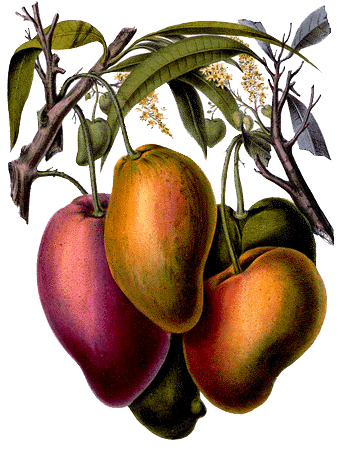
|
"There are three stages of chanting the holy name: chanting with offense, chanting as a liberated person, and chanting with full love of God. These progressive stages of chanting are like the ripening of a mango. An unripe mango tastes sour, but when the fruit is fully ripened, it tastes very sweet. Initially we may be reluctant to chant, but when we become liberated the chanting is so sweet that we cannot give it up. In this regard, Srila Rupa Gosvami has composed a beautiful verse describing the sweetness of the holy name of Krsna:
tunde tandavini ratim vitanute tundavali-labdhaye
karna-kroda-kadambini ghatayate karnarbudebhyah sprham
cetah-prangana-sangini vijayate sarvendriyanam krtim
no jane janita kiyadbhir amrtaih krsneti varna-dvayi
"I do not know how much nectar the two syllables Krs-na have produced. When we chant the holy name of Krsna, it appears to dance within the mouth, and we then desire many, many mouths. When the name of Krsna enters the holes of the ears, we desire many millions of ears. And when the holy name dances in the courtyard of the heart, it conquers the activities of the mind, and therefore all the senses become inert."
Second Chance, Chapter 15
|
Palmyra Fruit
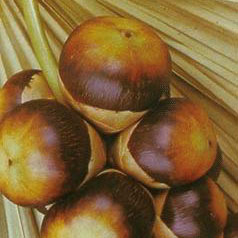
|
Palmyra Fruit, also known as Lontar, belongs to the coconut family. The palm grows 10-13 meters tall, and fruits are borne in bunches like coconuts, but they are much smaller and rounded. Palmyra Fruits are slightly flattened at both ends with colourful, dark purple skin and a set of green bracts at the base. The fleshy part of each seed resembles the meat of the coconut and there is present also a small quantity of water. Both the flesh and water are edible and eaten fresh or made into an ice drink.
|
Papaya
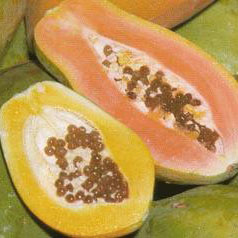
|
Papaya is also called pawpaw or melon zapote. All parts of the Papaya plant produce a milky juice that contains enzymes which have protein-digesting and milk-clotting properties. The fruits vary greatly in size, shape and flavor, but are usually eaten when ripe as dessert. The flesh is very rich in vitamin A, C and Calcium.
|
Passion Fruit
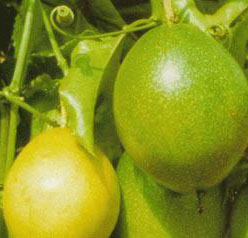
|
Passion Fruits are climbers which coil around fences or other trunks. The fruits are egg shaped and are green when immature, turning yellow or purplish on ripening. The skin is smooth, shiny and fairly hard with a fairly thick rind. Inside are numerous black seeds covered with orange yellow pulp. The fruits can be eaten fresh or made into juice, ice cream or cake.
|
Persimmon
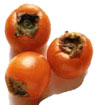
|
Persimmon is an astringent fruit that is bright orange in color. Persimmons are shaped like a large, slightly elongated tomato that almost comes to a point at the bottom. They should be fully ripe to be enjoyed, but when they're ripe they are somewhat mushy with a jelly-like texture that some find unattractive. The taste is similar to an overly sweet apricot with a smooth, slippery texture. Persimmons provide a substantial amount of Vitamin C and have a high beta carotene content.
|
Pomegranate
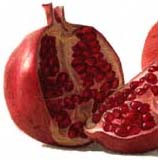
|
Pomegranates are nearly round with tough, leathery skin or rind that is typically yellow overlaid with light or deep pink to rich red. The fruit's interior is separated by membranous walls and white, spongy, bitter tissue into compartments packed with sacs filled with sweetly acid, juicy, red, pink or whitish pulp or aril. In each sac there is one angular, soft or hard seed.
|
|
Pommelo
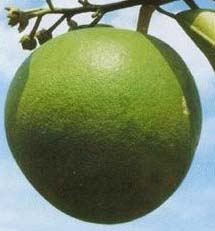
|
Pomelo is the biggest of all citrus fruits. Pomelo trees are evergreen and grow to a height of 10 meters. The fruit is round with flattened tip, with a rough outer skin that is light green to yellowish in colour. The inner skin is white to pinkish and spongy. The edible part of the fruit is made up of 10-15 segments which are juicy, and may be sweet or sour.
|
Sapota (Chikoo)
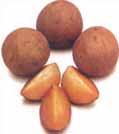
|
Chikoo Sapota is a small, round to oblong fruit that grows on trees. The outer skin is not very smooth, and is reddish-brown in color. The flesh is cream to light brown and gritty with 2-3 seeds. It is eaten fresh or in fruit salad, and the pulp is used for ice cream and yogurts.
|
Zizyphus
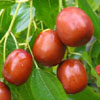
|
Zizyphus is also known as Jujuba or Mazanitas. The fruit is fleshy and meaty, smooth, orange or red, ovoid somewhat rounded with a bony and irregular furrowed stone within. Zizyphus fruit is nourishing and is said to purify the blood and assist in digestion.
|


|
|